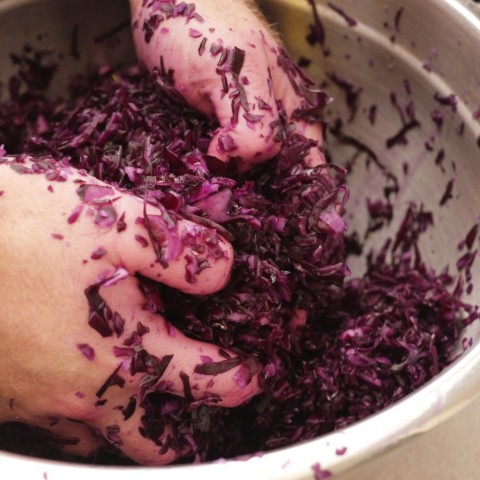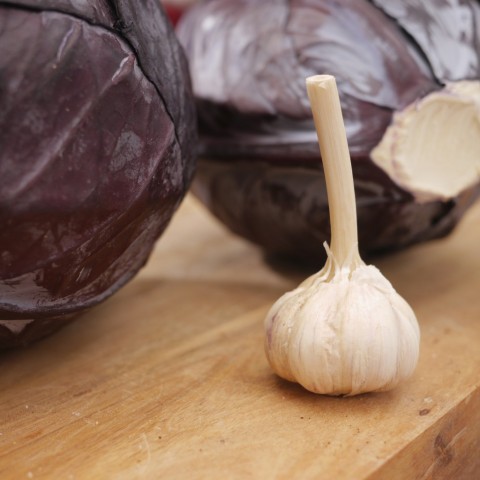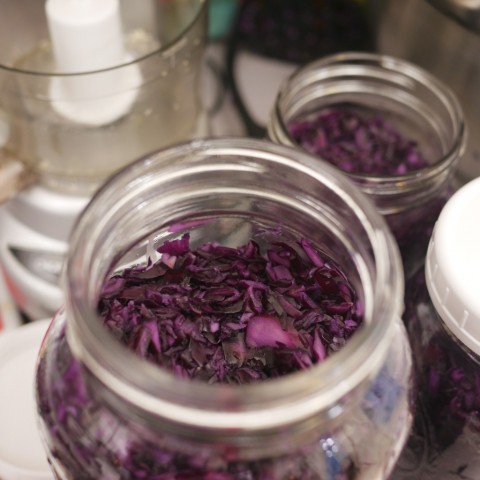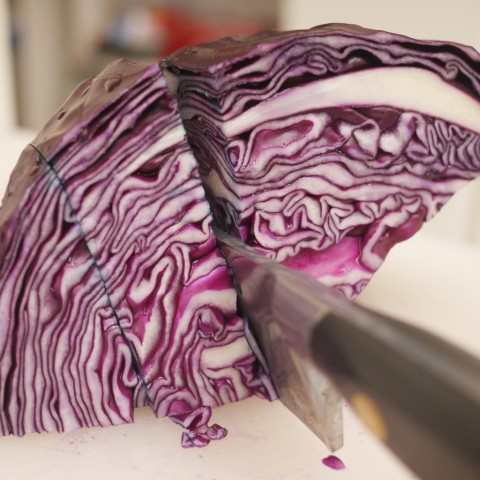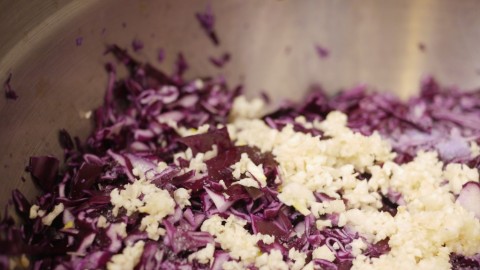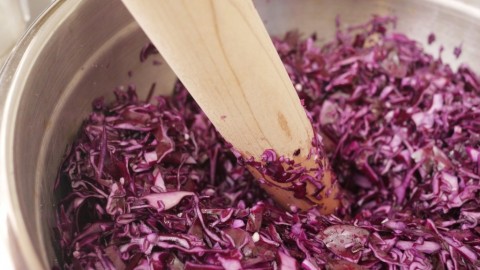One thing you should know about the making of sauerkraut is that it’s important to massage the shredded cabbage. You may pound it with a potato masher or with the end of a French rolling pin. And I always do, to start. But the goal of the exercise is to bruise the brassica bits, and induce them to yield up their water. The goal is to mix cabbage juice with salt, such that the vegetable essentially brines itself. And to accomplish this most effectively, hands are by far the best tool.
As I was making this batch of very purple sauerkraut, there was a moment when Sarah turned to say something to me and found me elbows deep in cabbage. I was moving it around, squeezing handfuls between my fingers, and apparently — says Sarah — singing softly to myself. So struck was she by my display of what she deemed pickling madness that she insisted on taking this photograph of my manual manipulations:
Then she jumped upstairs, returned forthwith with our copy of Moby Dick, and began reading to me outloud.
The section that she read me is long, so I’ll only quote part of it here. But to offer some context, it is from chapter XCIV, titled “The Squeeze of the Hand,” in which Ishmael discusses the method by which whalers keep the valuable spermaceti — the oil drawn from leviathan’s head — from hardening and becoming useless for industrial purposes on land. It was our business,, he says, to squeeze these lumps of congealed whale oil back into fluid.
Squeeze! squeeze! squeeze! all the morning long; I squeezed that sperm till I myself almost melted into it; I squeezed that sperm till a strange sort of insanity came over me; and I found myself unwittingly squeezing my co-laborers’ hands in it, mistaking their hands for the gentle globules. Such an abounding, affectionate, friendly, loving feeling did this avocation beget; that at last I was continually squeezing their hands, and looking up into their eyes sentimentally; as much as to say, – Oh! my dear fellow beings, why should we longer cherish any social acerbities, or know the slightest ill-humor or envy! Come; let us squeeze hands all round; nay, let us all squeeze ourselves into each other; let us squeeze ourselves universally into the very milk and sperm of kindness.
Would that I could keep squeezing that sperm for ever!
Sarah, of course, would never squeeze the shredded purple cabbage, herself. She has insisted that I make that clear to all of you. It leaves the hands stained a reddish hue. It leaves them with a vegetal smell — and in this case, a smell of raw garlic. While the color comes off easily enough, it can take several washings and lots of soap to make all of the odor go away. And she’ll have none of that.
But still, despite the drawbacks of this part of the process (and beyond its Melvillian weirdness), I would insist to you that it is an essential part of making really good sauerkraut. Squeezing the liquid out of the cabbage contributes a great deal to the end product’s texture and mouthfeel: more bruising now means more crunchy later. And having enough residual liquid to just about submerge the cabbage in its own juices prevents the formation of mold on top, and (it seems to me) speeds up the process of souring.
One needn’t, I think, squeeze until one succumbs to pickling madness. One needn’t feel the joy of it, and the sense of kinship with one’s fellow human beings. But do give it a try, at any rate. For a really good ferment, a hand in the cabbage is better than all the potato mashers in the world.
3 kilos Purple Cabbage (about two heads)
12 tsp Sea Salt
2 Heads of Garlic, peeled and minced
Wash five quarts worth of jars plus their attendant lids in very hot water, and leave them upside down to drip dry. Peel the cabbages’ outer leaves and wash the heads thoroughly. Then cut them into manageable wedges and — using a mandoline, food processor
, or knife
— shred the cabbage finely.
To a very large bowl — the biggest you have — add the cabbage, salt, and minced garlic. Then with a potato masher, the end of a French rolling pin, or (preferably) your hands, pound, massage, and squeeze it until it is all thoroughly bruised, and has yielded up a considerable pool of water at the bottom of the bowl. This should take, perhaps, ten to fifteen minutes.
Then, once your purple cabbage looks more or less like purple sauerkraut, load it a handful at a time into the jars, and pour the liquid in even measure over each. Compress the nascent purple sauerkraut with the back of a spoon. Then lid the jars loosely (you want gas to be able to escape), and store them somewhere dark and out of the way.
Every day, once a day, you’ll want to unlid your fermenting sauerkraut and compress it again. The time it will take for the cabbage to ferment depends on the temperature of your house and the vigor of your local microbial population. But you can expect, reasonably, to have a finished pickle in about a week.
Enjoy!
